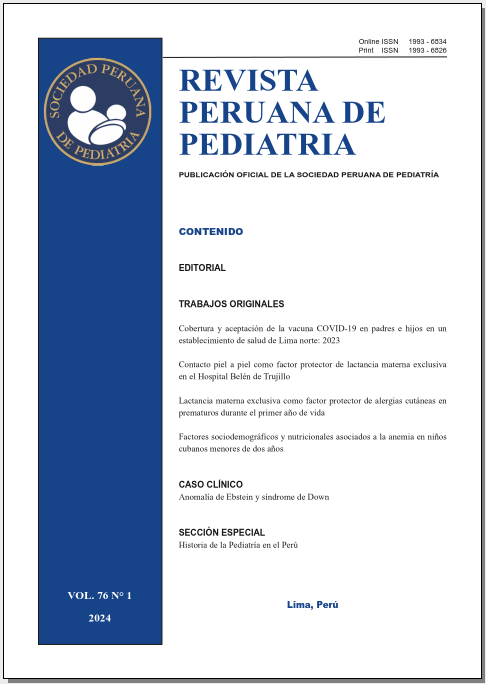Exclusive breastfeeding as a protective factor against skin allergies in premature infants during the first year of life
DOI:
https://doi.org/10.61651/rped.2024v76n1p3a1-3a7Keywords:
Breastfeeding and Complementary Feeding, Dermatitis, Atopic, Dermatitis, Contact, Infant, PrematureAbstract
Objective: To determine whether exclusive breastfeeding is a protective factor for skin allergies in premature infants during the first year of life. Materials and methods: Observational, analytical, retrospective casecontrol study, a sample of 212 patients; 106 premature patients with skin allergies (diagnosed and recorded in the clinical history by a pediatrician) and 106 premature patients without skin allergies, and their association with exclusive breastfeeding (EBF) during the first year of life at the Hospital II Luis Albrecht de Trujillo. The data obtained were typed in a data collection sheet of the medical records during a period of 11 years (2012 2022); the information obtained was tabulated and processed using the computerized program IBM SPSS Statistics 26.0 statistical program. Results: Of the total preterm patients with skin allergies, 26.4% received EBF; while those without skin allergies, 84% had received EBF. Preterm infants who received EBF had a 93% lower chance of having skin allergies compared to preterm infants who did not receive EBF [p<0.001; OR (95% CI): 0.07 (0.03 0.13)]. Additionally, the variable type of vaginal delivery turned out to be statistically significant [p<0.05; OR (95% CI): 0.492 (0.261 0.929), being considered a protective factor. Conclusions: Exclusive breastfeeding is a protective factor for skin allergies in infants born preterm during their first year of life, so this article reinforces the importance of insisting on EBF.
Downloads
Downloads
Published
How to Cite
Issue
Section
Categories
License
Copyright (c) 2024 Bulmer Franco Llerena Leiva, Ángel Pedro Ruiz Méndez

This work is licensed under a Creative Commons Attribution 4.0 International License.
Authors will retain the copyright and grant the right to publish their work in the journal while allowing third parties to share it under the Creative Commons Attribution license.
Articles are published under a Creative Commons license that allows sharing and adaptation with appropriate credit. CC BY 4.0 license. Available in English at https://creativecommons.org/licenses/by/4.0/
Authors may use other information disclosure formats as long as the initial publication in the journal is cited. The dissemination of the work through the Internet is recommended to increase citations and promote academic exchanges.
The published content does not necessarily reflect the specific point of view of the journal, and the authors assume full responsibility for the content of their article.



